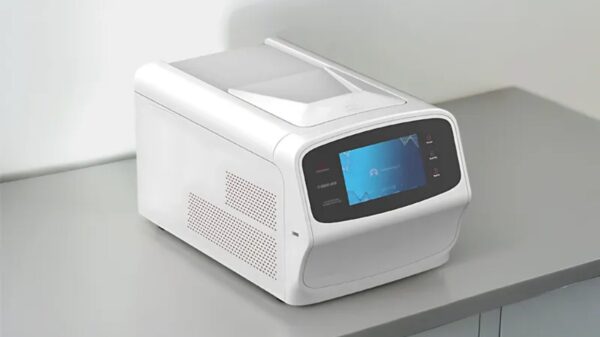
Advancements in genetics, clinical diagnostics, and molecular biology have transformed the way we analyze DNA and RNA. One of the most powerful innovations in this field is the Real-Time PCR System (qPCR System), a technology that enables precise, efficient, and real-time monitoring of DNA amplification.
Whether you are working in biotechnology, forensic science, medical research, or food safety, understanding how qPCR systems function and their advantages can greatly enhance your laboratory workflows.
What is a Real-Time PCR System?
A Real-Time PCR System, also known as quantitative PCR (qPCR), is an advanced polymerase chain reaction technique that allows for the simultaneous amplification and quantification of nucleic acids. Unlike traditional PCR, where DNA is analyzed at the end of the reaction, qPCR continuously measures DNA amplification in real-time, using fluorescent markers.
This real-time fluorescence detection makes qPCR the preferred choice for applications that require high accuracy, sensitivity, and quantification capabilities, such as gene expression analysis, disease detection, and viral load monitoring.
How Real-Time PCR Works
The qPCR process follows the same basic steps as traditional PCR but incorporates fluorescence-based detection:
- Denaturation: The DNA strands separate when heated.
- Annealing: Short primers bind to specific target sequences.
- Extension: DNA polymerase synthesizes new DNA strands.
During amplification, fluorescent dyes or probes are used to monitor the progress of DNA replication. The fluorescence intensity increases with each PCR cycle, allowing real-time detection of nucleic acid quantities.
The system calculates the Cycle Threshold (Ct) value, which represents the cycle at which the fluorescence surpasses a set detection threshold. A lower Ct value means a higher concentration of the target DNA or RNA.
Comparing Real-Time PCR, Digital PCR, and Traditional PCR
PCR technology has evolved significantly over the years, leading to different approaches for DNA amplification and quantification. Here’s how qPCR compares to traditional PCR and digital PCR (dPCR):
| Feature | Real-Time PCR (qPCR) | Traditional PCR | Digital PCR (dPCR) |
| Detection Method | Fluorescence during amplification | End-point gel electrophoresis | Partitioning into microreactions |
| Quantification | Relative or absolute | Semi-quantitative | Absolute, no standard curve needed |
| Sensitivity | High | Lower | Ultra-high |
| Processing Time | Fast | Longer due to post-processing | Moderate |
| Contamination Risk | Low (closed system) | High (open system) | Low (sealed microreactions) |
| Applications | Gene expression, virus detection, genotyping | DNA cloning, mutation analysis | Rare mutation detection, liquid biopsy analysis |
If you need fast, sensitive, and real-time quantification, qPCR is the optimal choice. For applications requiring absolute quantification and high precision, dPCR may be more suitable.
Key Applications of Real-Time PCR Systems
The versatility and precision of qPCR make it an essential tool in multiple fields:
1. Disease Detection & Viral Load Quantification
Real-time PCR plays a crucial role in clinical diagnostics, especially for detecting infectious diseases such as COVID-19, HIV, tuberculosis, and influenza. It helps in monitoring viral load, allowing doctors to track disease progression and treatment effectiveness.
2. Gene Expression & Cancer Research
qPCR allows scientists to measure gene expression levels, helping researchers understand cancer pathways, genetic disorders, and drug responses. It is widely used in oncology to identify tumor biomarkers and assess gene regulation mechanisms.
3. SNP Genotyping & Genetic Variation Studies
Single nucleotide polymorphisms (SNPs) play a significant role in genetic variation. qPCR enables rapid and reliable SNP genotyping, making it a valuable tool for personalized medicine, ancestry testing, and genetic trait analysis.
4. Food Safety & GMO Detection
In agriculture and food production, qPCR helps detect genetically modified organisms (GMOs) and foodborne pathogens like Salmonella and Listeria, ensuring compliance with food safety regulations.
5. Environmental & Forensic Science
Forensic experts use qPCR for DNA analysis in crime scene investigations, while environmental scientists use it to detect contaminants, microbial populations, and genetic biodiversity in ecological studies.
Choosing the Right Real-Time PCR System
Selecting a qPCR system depends on your research needs, budget, and laboratory setup. Here are key factors to consider:
1. Sample Throughput & Well Capacity
qPCR systems come in different formats, including 48-well, 96-well, and 384-well plates. Laboratories handling large volumes of samples benefit from high-throughput qPCR machines.
2. Fluorescence Detection Capabilities
The choice of detection chemistry determines sensitivity and specificity:
- SYBR Green: Binds to double-stranded DNA; cost-effective but can bind non-specifically.
- TaqMan Probes: Sequence-specific; highly accurate with multiplexing capabilities.
3. Multiplexing Efficiency
If you need to detect multiple DNA targets in a single reaction, opt for a qPCR system with multiplexing capabilities, which supports multiple fluorescent dyes.
4. Speed & Automation
Modern qPCR machines offer fast thermal cycling, reducing run times to as little as 30 minutes. Automated data processing, cloud connectivity, and remote monitoring improve workflow efficiency.
5. Compatibility with Digital PCR (dPCR)
Some hybrid qPCR systems can switch between qPCR and digital PCR (dPCR) modes, allowing greater flexibility for quantitative accuracy.
Advantages of Real-Time PCR Systems
Switching to real-time PCR provides laboratories with multiple benefits:
- High Sensitivity & Accuracy: Detects even small amounts of DNA/RNA.
- Real-Time Quantification: Provides absolute or relative quantification without gel electrophoresis.
- Fast & Efficient: Reduces assay time while increasing throughput.
- Closed-Tube System: Minimizes contamination risks.
- Wide Dynamic Range: Accurately detects gene expression over multiple orders of magnitude.
Compared to traditional PCR, qPCR eliminates labor-intensive steps, ensuring faster and more reproducible results.
Final Thoughts
Whether you are working in clinical research, genetic testing, infectious disease diagnostics, or biotechnology, Real-Time PCR Systems offer speed, accuracy, and high-throughput capabilities. This technology has revolutionized molecular biology, enabling real-time monitoring of DNA amplification, quantitative analysis, and rapid diagnostics.
By choosing the right qPCR system with multiplexing, fast thermal cycling, and automation features, you can enhance laboratory efficiency, improve data reliability, and accelerate scientific discoveries.
Investing in real-time PCR technology ensures that your research or diagnostic workflows remain at the forefront of precision genetic analysis.